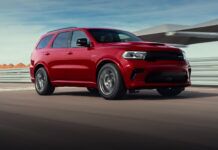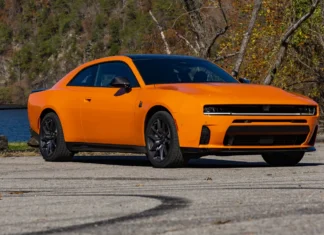Each of these family haulers cost a substantial amount of money, but have a different flavor to the others. So which one is best for you?
When we have a range of vehicles to schedule out from automakers’ press fleets, the stars occasionally align so that we’ll get two or more vehicles that directly compete, at least in a few areas. That’s more or less what we have here, as the Dodge Durango, Nissan Armada and Toyota Sequoia all landed at our HQ within a week-long time span for us to compare. In the video below, Roman takes a look at each of these three big-old family haulers to see which is the better spend for your $80,000-plus: a pure muscle machine, more of a “sporty” flavor or the straight-up luxury model?
Here’s the thing: As you see them here, the Dodge Durango SRT Hellcat, Nissan Armada Nismo and Toyota Sequoia Capstone will each set you back somewhere around $80K to $84K, give or take a couple thousand in either direction. There are less expensive versions of all three, of course, but if you wanted to get the most raw power, sporty looks or luxurious features (short of shopping the higher-end luxury brands), you could feasibly cross-shop these three.
The Dodge Durango SRT Hellcat can thrill (or terrify) up to seven passengers, but it’s showing its age
Now, most keen drivers are going to go to the most obviously badass option here: the 2026 Dodge Durango SRT Hellcat. This isn’t just any Hellcat, either, as Dodge brought the “Jailbreak” option to its signature SUV this year. It doesn’t get you any more power, as the 6.2-liter supercharged V8 still kicks out a volcanic 710 horsepower and 645 lb-ft of torque. What it does do, though, is open up as many as 6 million possible configurations (or so the automaker claims) in terms of exterior color, fender badges, wheels, seats, stripes and more to create a one-of-one setup, or at least close to it.
On paper, the Jailbreak option doesn’t seem like a bad deal at $995. It’s only when you dive into those unlocked options, each of which you’ll have to pay for separately like the $1,495 stripes or $2,995 Demonic Red seats, that the price tag may get a little scary.
Keep in mind, the current-generation Dodge Durango has been around since the 2011 model year, and will stay in production until 2029. This SUV is nearly two decades old, and while it has aged remarkably well (and the SRT Hellcat is always going to be a badass option), its platform and design do put it behind the pack in terms of actual practicality. You’ll also still have to pay a couple more thousand should you actually want a third row of seats ($995) or the trailer tow group ($1,195).
As tested, our Durango SRT Hellcat Jailbreak comes out to approximately $86,000.
One number does dwarf the other two, naturally: the 0-60 time. At just 3.5 seconds, the Dodge Durango SRT Hellcat is quicker than just about any other mainstream car out there, and puts a wide range of sports cars into an embarrassing position. Couple that with the sensation of all that grunt by way of the Launch Control and configurable drive modes, and you can’t help but laugh maniacally every time you leave everyone else in the dust at the lights.
The 2026 Nissan Armada Nismo is a big deal — literally
Ever since Nissan announced it, we’ve been struggling to wrap our heads around the Nissan Armada Nismo. Not necessarily the technical details, since it’s effectively a sportier looking version with a bit more power. No, the real head scratcher is why give this 6,102-pound SUV a sportier treatment in the same vein as the Z Nismo. You know, an actual sports car.
The new Nissan Armada is, by most metrics, a major improvement over the old one, which (like the Durango) was also showing its age. Now, you get a 3.5-liter twin-turbocharged V6 under the hood of your family hauler, more assertive styling, a greater amount of tech and a 9-speed automatic transmission. The Armada also brings an integrated trailer brake controller to the mix, making its 8,500-pound towing capacity more usable.
Apart from the assorted splitters, spoilers, skirts and Stealth Gray paint, the Nismo’s twin-turbo V6 kicks out 35 more horsepower than other trims, bringing the output up to 460 horsepower, while the SUV’s 516 lb-ft of torque remains the same. Mind you, that bump doesn’t make too much of a difference in terms of out-and-out speed, as the Armada still takes a (relatively) leisurely 6-and-a-bit seconds to get from 0-60.
Across the board, the 2026 Nissan Armada also offers the largest cargo volume of these three. While the Durango offers up to 85.1 cubic feet with all second (and/or third)-row seats folded and the Sequoia offers 86.9 cu. ft., the Armada’s volume expands to 97.1 cu. ft. It also offers up 56.3 cu. ft. with just the third row down, also beating the other two.
All-in, this Armada Nismo will set you back $83,735, so it’s also the least expensive of the three SUVs we’re testing today.
The Toyota Sequoia is all-hybrid, but doesn’t otherwise stray far from convention.
In terms of its overall stature, this new Toyota Sequoia Capstone tracks pretty close to the Nissan Armada. Unlike Nissan, though, Toyota is leaning more heavily into its hybrid powertrains with each new generation, and this three-row, truck-based SUV is no exception. To that end, all Sequoia models get a 3.4-liter twin-turbocharged V6 hybrid powertrain shared with the Toyota Tundra (and Lexus LX 700h). Here, you get 437 horsepower and 583 lb-ft of torque thanks to the engine and electric motors, with power making its way to the ground through a 10-speed automatic transmission.
While the Sequoia lineup kicks off just over $60,000, this top-end Capstone model offers the most luxurious upgrade path — with a price tag to match. Buying this trim will set you back at least $84,435, but opting for even more equipment like the self-leveling rear air suspension or towing mirrors will drive that price even higher. As tested, our Sequoia came out to $89,535.




















